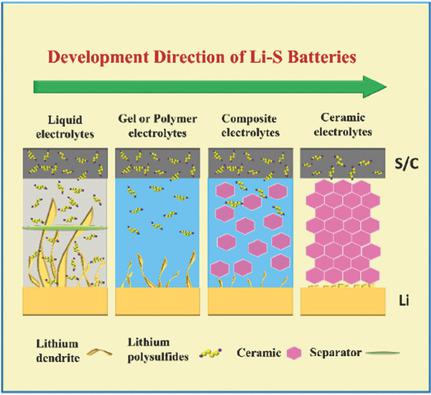当前位置:
X-MOL 学术
›
Adv. Funct. Mater.
›
论文详情
Our official English website, www.x-mol.net, welcomes your
feedback! (Note: you will need to create a separate account there.)
Progress and Perspective of Solid‐State Lithium–Sulfur Batteries
Advanced Functional Materials ( IF 18.5 ) Pub Date : 2018-03-15 , DOI: 10.1002/adfm.201707570 Danni Lei 1, 2 , Kai Shi 1, 2 , Heng Ye 1, 2 , Zipei Wan 1, 2 , Yanyan Wang 1 , Lu Shen 1, 2 , Baohua Li 1 , Quan-Hong Yang 3 , Feiyu Kang 1, 2, 4 , Yan-Bing He 1
Advanced Functional Materials ( IF 18.5 ) Pub Date : 2018-03-15 , DOI: 10.1002/adfm.201707570 Danni Lei 1, 2 , Kai Shi 1, 2 , Heng Ye 1, 2 , Zipei Wan 1, 2 , Yanyan Wang 1 , Lu Shen 1, 2 , Baohua Li 1 , Quan-Hong Yang 3 , Feiyu Kang 1, 2, 4 , Yan-Bing He 1
Affiliation

|
Due to high energy density, low cost, and nontoxicity, lithium–sulfur (Li–S) batteries are considered as the most promising candidate to satisfy the requirement from the accelerated development of electric vehicles. However, Li–S batteries are subjected to lithium polysulfides (LiPSs) shuttling due to their high dissolution in liquid electrolyte, resulting in low columbic efficiency and poor cycling performance. Moreover, the Li metal as an indispensable anode of Li–S batteries shows serious safety issues derived from the lithium dendrite formation. The replacement of liquid electrolytes with solid‐state electrolytes (SSEs) has been recognized as a fundamental approach to effectively address above problems. In this review, the progress on applying various classes of SSEs including gel, solid‐state polymer, ceramic, and composite electrolytes to solve the issues of Li–S batteries is summarized. The specific capacity of Li–S batteries is effectively improved due to the suppression of LiPSs shuttling by SSEs, while the rate and cycling performance remain relatively poor owing to the limited ionic conductivity and high interfacial resistance. Designing smart electrode/electrolyte integrated architectures, enabling the high ionic transportation pathway and compatible electrode/electrolyte interface, may be an effective way to achieve high performance solid‐state Li–S batteries.
中文翻译:

固态锂硫电池的研究进展与展望
由于高能量密度,低成本和无毒性,锂硫(Li–S)电池被认为是满足电动汽车加速发展需求的最有前途的候选者。但是,由于Li–S电池在液体电解质中的溶解度很高,因此会经受多硫化锂(LiPS)的穿梭作用,从而导致低的哥伦布效率和不良的循环性能。此外,作为Li–S电池必不可少的阳极的锂金属还显示出严重的安全问题,这些问题源于锂枝晶的形成。用固态电解质(SSE)代替液体电解质已被认为是有效解决上述问题的基本方法。在这篇评论中,应用了各种类型的SSE的进展,包括凝胶,固态聚合物,陶瓷,总结了用于解决Li–S电池问题的复合电解质。由于SSE抑制了LiPS的穿梭,有效地提高了Li–S电池的比容量,而由于有限的离子电导率和较高的界面电阻,其速率和循环性能仍然相对较差。设计智能电极/电解质集成架构,实现高离子传输路径和兼容的电极/电解质界面,可能是实现高性能固态Li–S电池的有效途径。由于有限的离子电导率和较高的界面电阻,因此速率和循环性能仍然相对较差。设计智能电极/电解质集成架构,实现高离子传输路径和兼容的电极/电解质界面,可能是实现高性能固态Li–S电池的有效途径。由于有限的离子电导率和较高的界面电阻,因此速率和循环性能仍然相对较差。设计智能电极/电解质集成架构,实现高离子传输路径和兼容的电极/电解质界面,可能是实现高性能固态Li–S电池的有效途径。
更新日期:2018-03-15
中文翻译:

固态锂硫电池的研究进展与展望
由于高能量密度,低成本和无毒性,锂硫(Li–S)电池被认为是满足电动汽车加速发展需求的最有前途的候选者。但是,由于Li–S电池在液体电解质中的溶解度很高,因此会经受多硫化锂(LiPS)的穿梭作用,从而导致低的哥伦布效率和不良的循环性能。此外,作为Li–S电池必不可少的阳极的锂金属还显示出严重的安全问题,这些问题源于锂枝晶的形成。用固态电解质(SSE)代替液体电解质已被认为是有效解决上述问题的基本方法。在这篇评论中,应用了各种类型的SSE的进展,包括凝胶,固态聚合物,陶瓷,总结了用于解决Li–S电池问题的复合电解质。由于SSE抑制了LiPS的穿梭,有效地提高了Li–S电池的比容量,而由于有限的离子电导率和较高的界面电阻,其速率和循环性能仍然相对较差。设计智能电极/电解质集成架构,实现高离子传输路径和兼容的电极/电解质界面,可能是实现高性能固态Li–S电池的有效途径。由于有限的离子电导率和较高的界面电阻,因此速率和循环性能仍然相对较差。设计智能电极/电解质集成架构,实现高离子传输路径和兼容的电极/电解质界面,可能是实现高性能固态Li–S电池的有效途径。由于有限的离子电导率和较高的界面电阻,因此速率和循环性能仍然相对较差。设计智能电极/电解质集成架构,实现高离子传输路径和兼容的电极/电解质界面,可能是实现高性能固态Li–S电池的有效途径。











































 京公网安备 11010802027423号
京公网安备 11010802027423号